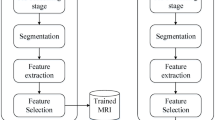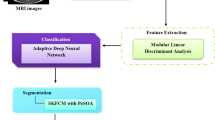Abstract
Magnetic resonance images (MRI) is the imperative imaging modality utilized in medical diagnosis tool for detecting brain tumors. The MRI possess the capability to offer detailed information based on anatomical structures of brain. However, the major obstacle in the MRI classification is semantic gap among low-level visual information obtained by the high-level information alleged from clinician and MRI machine. This paper proposes the novel technique, named Chaotic whale cat swarm optimization-enabled Deep Convolutional Neural Network (CWCSO-enabled Deep CNN) for brain tumor classification. Here, pre-processing is employed for removing noise and artifacts contained in image. Moreover, Fractional Probabilistic Fuzzy Clustering is employed for segmentation for identifying the tumor regions. Consequently, the feature extraction is carried out from segmented regions of image using wavelet transform, Empirical Mode Decomposition (EMD), scattering transform, Local Directional Pattern (LDP) and information theoretic measures. In addition, Significant LOOP is newly developed through modifying Significant Local Binary Pattern (SLBP) by LOOP. The extracted features are induced by Deep CNN to determine non-tumor, edema, tumor, and enhanced tumor, which is trained by the proposed CWCSO. Thus, the resulted output of proposed CWCSO-based Deep CNN is employed for brain tumor classification. The proposed model showed improved results with maximal specificity of 98.59%, maximal accuracy of 95.52%, and maximal sensitivity of 97.37%, respectively.







Similar content being viewed by others
References
Abd-Ellah MK, Awad AI, Khalaf AAM, Hamed HFA (2016) Design and implementation of a computer-aided diagnosis system for brain tumor classification. In: ICM2016: 28th international conference on microelectronics. pp 73–76
Ahmadvand A, Daliri MR, Zahiri SM (2017) Segmentation of brain MR images using a proper combination of DCS based method with MRF. Multimedia Tools Appl 77(7):8001–8018
Amin J, Sharif M, Yasmin M, Fernandes SL (2017) A distinctive approach to brain tumor detection and classification using MRI. Pattern Recognit Lett 10:116–156
Anbeek P, Vincken KL, Viergever MA (2008) Automated MS-lesion segmentation by K-nearest neighbor classification. Midas J 1–8
Angulakshmi M, Priya GGL (2018) Brain tumour segmentation from MRI using superpixels based spectral clustering. J King Saud Univ Comput Inf Sci. https://doi.org/10.1016/j.jksuci.2018.01.009
Anitha V, Murugavalli S (2016) Brain tumour classification using two-tier classifier with adaptive segmentation technique. IET Comput Vis 10(1):9–17
Badran EF, Mahmoud EG, Hamdy N (2010) An algorithm for detecting brain tumors in MRI images. In: Proceedings, ICCES’2010—2010 international conference on computer engineering and systems. pp 368–373.
Bahrami M, Bozorg-Haddad O, Chu X (2018) Cat Swarm Optimization (CSO) algorithm. In: Advanced Optimization by Nature-Inspired Algorithms, Computational Intelligence, pp 9–18
Bauer S, Wiest R, Nolte LP, Reyes M (2013) A survey of MRI-based medical image analysis for brain tumor studies. Phys Med Biol 58(13):R97–R129
Bhaladhare PR, Jinwala DC (2018) A clustering approach using fractional calculus-bacterial foraging optimization algorithm for k-anonymization in privacy preserving data mining. Adv Comput Eng 2014:1–12
Cabria I, Gondra I (2017) MRI segmentation fusion for brain tumor detection. Inf Fusion 36:1–9
Chakraborti T, Mccane B, Mills S, Pal U (2017) Loop descriptor : encoding repeated local patterns for fine-grained visual identification of Lepidoptera. IEEE Signal Process Lett 1–5
Chakraborti T, McCane B, Mills S, Pal U (2018) LOOP descriptor: local optimal-oriented pattern. IEEE Signal Process Lett 25(5):635–639
Charutha S, Jayashree MJ (2014) An efficient brain tumor detection by integrating modified texture based region growing and cellular automata edge detection. In: 2014 international conference on control, instrumentation, communication and computational technologies (ICCICCT 2014). pp 1193–1199
Chen H, Qin Z, Ding Y, Tian L, Qin Z (2020) Brain tumor segmentation with deep convolutional symmetric neural network. Neurocomputing 392:305–313
Dian R, Li S, Guo A, Fang L (2018) deep hyperspectral image sharpening. IEEE Trans Neural Netw Learn Syst 29(11):5345–5355
Huang S, Zhang Y, Liu Z (2016) Image feature extraction and analysis based on Empirical mode decomposition. In: Proceedings of 2016 IEEE advanced information management, communicates, electronic and automation control conference, IMCEC 2016, no. 3. pp 615–619
Ilunga-Mbuyamba E, Avina-Cervantes JG, Cepeda-Negrete J, Ibarra-Manzano MA, Chalopin C (2017) Automatic selection of localized region-based active contour models using image content analysis applied to brain tumor segmentation. Comput Biol Med 91:69–79
Ismael MR, Abdel-Qader I (2018) Brain tumor classification via statistical features and back-propagation neural network. In: IEEE international conference on electro/information technology. pp 252–257
Jason J et al (2008) Efficient multilevel brain tumor segmentation with integrated bayesian model classification. IEEE Trans Med Imaging 27(5):629–640
John P (2012) Brain tumor classification using wavelet and texture based neural network. Int J Sci Eng Res 3(10):1–7
Karnan M, Logheshwari T (2010) Improved implementation of brain MRI image segmentation using Ant Colony system. In: 2010 IEEE international conference on computational intelligence and computing research (ICCIC 2010). pp 722–725
Kharat KD, Kulkarni PP, Nagori MB (2012) Brain tumor classification using neural network based methods. Int J Comput Sci Inform 1(4):85–90
Kumar Mallick P, Ryu SH, Satapathy SK, Mishra S, Nguyen GN, Tiwari P (2019) Brain MRI image classification for cancer detection using deep wavelet autoencoder-based deep neural network. IEEE Access 7:46278–46287
Lavanyadevi R, MacHakowsalya M, Nivethitha J, Niranjil Kumar A (2017) Brain tumor classification and segmentation in MRI images using PNN. In: Proceedings of the 2017 IEEE international conference on electrical, instrumentation and communication engineering (ICEICE 2017), vol 2017-December. pp 1–6
Ludwig O, Nunes U, Araujo R (2014) Eigenvalue decay : a new method for neural network regularization. Neurocomputing 124:33–42
Mathew AR, Anto PB (2018) Tumor detection and classification of MRI brain image using wavelet transform and SVM. In: Proceedings of the IEEE international conference on signal processing and communication (ICSPC 2017), vol 2018-January, no. July. pp 75–78
Meenakshi R, Anandhakumar P (2015) a hybrid brain tumor classification and detection mechanism using Knn and Hmm. Curr Med Imaging Rev 11(2):70–76
Menze BH et al (2015) The multimodal brain tumor image segmentation benchmark (BRATS). IEEE Trans Med Imaging 34(10):1993–2024
Naik J, Patel PS (2013) Tumor detection and classification using decision tree in brain MRI. Int J Eng Dev Res 14:49–53
Nefti S, Oussalah M (2004) Probabilistic-fuzzy clustering algorithm. In: IEEE international conference on systems, man and cybernetics, vol 5. pp 4786–4791
Nilesh et al (2017) Image analysis for MRI based brain tumor detection and feature extraction using biologically inspired BWT and SVM. Int J Biomed Imaging. https://doi.org/10.1155/2017/9749108
Parveen, Singh A (2015) Detection of brain tumor in MRI images, using combination of fuzzy c-means and SVM. In: 2nd international conference on signal processing and integrated networks (SPIN) 2015. pp 98–102
Raju AR, Suresh P, Rao RR (2018) Bayesian HCS-based multi-SVNN: a classification approach for brain tumor segmentation and classification using Bayesian fuzzy clustering. Biocybern Biomed Eng 38(3):646–660
Rashid MHO, Mamun MA, Hossain MA, Uddin MP (2018) Brain tumor detection using anisotropic filtering, SVM classifier and morphological operation from MR images. In: International conference on computer, communication, chemical, material and electronic engineering (IC4ME2 2018). pp 3–6
Sajid S, Hussain S, Sarwar A (2019) Brain tumor detection and segmentation in MR images using deep learning. Arab J Sci Eng 44(11):9249–9261
Sharmila R, Suresh Joseph K (2018) Brain tumour detection of MR image using Naïve Beyer classifier and support vector machine. Int J Sci Res Comput Sci Eng Inf Technol 3(3):2456–3307
Suhag S, Saini LM (2015) Automatic brain tumor detection and classification using SVM classifier. Int J Adv Sci Eng Technol 3(1):119–123
Thillaikkarasi R, Saravanan S (2019) An enhancement of deep learning algorithm for brain tumor segmentation using kernel based CNN with M-SVM. J Med Syst 43(4):1–7
Usman K, Rajpoot K (2017) Brain tumor classification from multi-modality MRI using wavelets and machine learning. Pattern Anal Appli 20:871–881
Vojt J (2016) Deep neural networks and their implementation. Charles University, Prague
Zulpe N, Pawar V (2012) GLCM textural features for brain tumor classification. Int J Comput Sci Issues 9(3):354–359
Author information
Authors and Affiliations
Corresponding author
Additional information
Publisher's note
Springer Nature remains neutral with regard to jurisdictional claims in published maps and institutional affiliations.
Rights and permissions
About this article
Cite this article
Jemimma, T.A., Raj, Y.J.V. Significant LOOP with clustering approach and optimization enabled deep learning classifier for the brain tumor segmentation and classification. Multimed Tools Appl 81, 2365–2391 (2022). https://doi.org/10.1007/s11042-021-11591-8
Received:
Revised:
Accepted:
Published:
Issue Date:
DOI: https://doi.org/10.1007/s11042-021-11591-8




